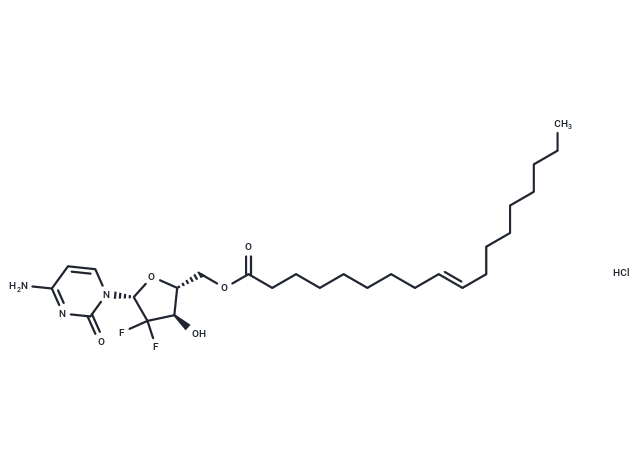Shopping Cart
- Remove All
 Your shopping cart is currently empty
Your shopping cart is currently empty

Gemcitabine elaidate (CP-4126) hydrochloride is a lipophilic pro-drug of Gemcitabine, converted to Gemcitabine by esterases for phosphorylation. Unlike gemcitabine, Gemcitabine elaidate hydrochloride can be administered orally, displaying schedule and dose-dependent toxicity and antitumor activity.

| Pack Size | Price | Availability | Quantity |
|---|---|---|---|
| 1 mg | $31 | In Stock | |
| 5 mg | $72 | In Stock | |
| 10 mg | $97 | In Stock | |
| 25 mg | $185 | In Stock | |
| 50 mg | $337 | In Stock |
| Description | Gemcitabine elaidate (CP-4126) hydrochloride is a lipophilic pro-drug of Gemcitabine, converted to Gemcitabine by esterases for phosphorylation. Unlike gemcitabine, Gemcitabine elaidate hydrochloride can be administered orally, displaying schedule and dose-dependent toxicity and antitumor activity. |
| In vitro | Gemcitabine elaidate hydrochloride, at concentrations ranging from 0.2 nM to 1 mM over 72 hours, effectively inhibits the growth of both gemcitabine-sensitive and drug-resistant cells, demonstrating IC50 values varying from 0.0015 to 91 μM across different cell lines (L1210/L5, L4A6, BCLO, Bara-C, C26-A, C26-G, A2780, AG6000, THX, LOX, MOLT4, and MOLT4/C8, respectively). Additionally, exposure to gemcitabine elaidate (0.5 nM to 1 μM; 72 h) in A549 and WiDR cells leads to a significant increase in S phase accumulation and triggers dose-dependent cell death. Detailed cell cycle analysis of A549 and WiDR cells treated with various concentrations (0.0005 to 1.0 μM) for 72 hours confirmed the induction of G2/M and S phase accumulation. |
| In vivo | Gemcitabine elaidate hydrochloride, administered intraperitoneally (i.p.) at doses ranging from 25 to 120 mg/kg every three days for five doses, has demonstrated efficacy in inhibiting the growth of solid tumor xenografts in non-small cell lung cancer (EKVX), non-classifiable sarcoma (MHMX), fibrous histiocytoma (TAX II-1), malignant melanoma (THX), prostate cancer (CRL-1435), and pancreatic cancer (PANC-1). Furthermore, when given orally (p.o.) at 10-20 mg/kg following the same schedule, it exhibits acceptable toxicity levels and significant antitumor activity against colon cancer xenograft in Co6044 bearing mice. A once-daily oral dose for five days shows favorable toxicity and antitumor profiles; however, a 15 mg/kg dose proves highly toxic in the same colon cancer model. Female BALB/c nude (nu/nu) mice, aged 5-8 weeks and weighing 20-27 g, served as the animal model for these experiments, bearing various tumors including EKVX, H-146, MHMX, TAX II-1, OHS, THX, MA-11, CRL-1435, PANC-1, and MiaPaCa-2. The treatment notably inhibited tumor growth in specific models, achieving T/C values of 7%, 1%, 30%, 7%, 9%, and 12% for EKVX, MHMX, TAX II-1, THX, CRL-1435, and PANC-1, respectively. |
| Alias | Gemcitabine elaidate hydrochloride(210829-30-4(free base)), Gemcitabine 5'-elaidate hydrochloride, CP-4126 hydrochloride, CO-101 hydrochloride |
| Molecular Weight | 564.11 |
| Formula | C27H44ClF2N3O5 |
| Cas No. | 2918768-08-6 |
| Smiles | O[C@@H](C(F)(F)[C@H](N1C(N=C(C=C1)N)=O)O2)[C@H]2COC(CCCCCCC/C=C/CCCCCCCC)=O.Cl |
| Relative Density. | no data available |
| Storage | Powder: -20°C for 3 years | In solvent: -80°C for 1 year | Shipping with blue ice. | ||||||||||||||||||||
| Solubility Information | DMSO: 5.64 mg/mL (10 mM), Sonication is recommended. | ||||||||||||||||||||
Solution Preparation Table | |||||||||||||||||||||
DMSO
| |||||||||||||||||||||

Copyright © 2015-2025 TargetMol Chemicals Inc. All Rights Reserved.